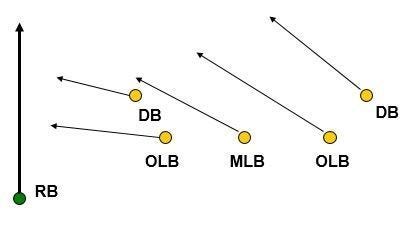Thought for the Week
“Blessed are the flexible, for they will not be bent out of shape”
If you've every played Twister you know how important positioning is…
But, do you know how that translates to your business?
If not, time to stretch and throw on some yoga pants so you don't get bent out of shape with this one.
Here’s the Roundup
I'm going to talk about:
How positioning wins championships
Examples of positioning
Applying it to your business
Not subscribed yet? This is your lucky day
The Geometry of Sports
How positioning wins championships
In this week's Sunday Setup I wrote about how the average professional soccer player only touches the ball for ~3 minutes in a 90 minute soccer match: so what are they doing the other ~87 minutes?
The answer, of course, is positioning.
Soccer is a game of angles. Passing lanes, defensive zones, support channels; all of these things are based on angles.
Moving the ball up the field - or taking it away - is heavily dependent on where the other 21 players are located at any given time. It really is the thing that wins championships.
It's not just soccer, either: baseball relies on pursuit angles for fielding, basketball relies on it for ball movement and defense, and football relies on it for tackling.
(Check out this pursuit angle chart for football.)
Down Dog and All the Rest
Example of Positioning
I've always been curious about the English take of Sanskrit names given to yoga poses (but not curious enough to look it up).
First off, I've never seen a pigeon do anything that looks like pigeon pose…
Here are some positions you can utilize that actually make sense with their names.
Against-Brand Positioning
The strategy is about setting yourself up as the “anti” to an established brand or status quo.
This approach makes you look bold and gives a rally point to people outside of the mainstream.
Hyper-Niche Positioning
Simply put, Seth Godin's “Smallest Viable Audience.” This is about getting so specialized that you are literally the only brand doing this thing.
This approach can be a slow starter, but it can grow a fiercely loyal audience.
Value Positioning
This strategy highlights what your client gets for the price. This is an overdeliver strategy and can pay off in word of mouth traffic from experiences that were better than expected.
Convenience Positioning
Make difficult things simple for people and you'll quickly find a market that comes to you (think UberEats, Carvana, Netlfix).
Problem / Solution Positioning
Everyone has some problem. Identifying it and positioning yourself as the solution is a common strategy for coaches dealing with intangibles like life/mindset change.
Leader-based Positioning
Positioning yourself as an industry expert second-to-none is a strategy. This has the benefits of authority and setting norms and pricing, but it requires a lot of proof and suffers from competition targeting.
Price-based Positioning
Price-based is exactly what it sounds like - using pricing to create an audience. High pricing can give the illusion of quality and distinction, low pricing can create affordability and accessibility.
LEGO-style Instructions
Applying it to your business
Ok, you've see some examples for how to position your brand to stand out and connect with your audience, wonderful.
Now, how to apply this?
Pick a Category
Determine which makes the most sense with your brand. Look at: Your service - what does it most align with?
Your industry - where are the opportunities?
Your target audience - what are they looking for?
(This step can take a long time)
Examine your Brand
Once you pick the positioning that makes the most sense, examine your brand to find the areas you can exploit most effectively.
If you're an Against-brand, this might be your voice or personality; if you're a Leader-brand this will probably be your point of view or proof-of-concept.
Test it
Start creating messaging and content that highlights your position and pay attention to the data - feedback, engagement, traffic, growth, sales, attitude/emotions.
Tweak it or Restart
If it's gaining traction and you feel good about it, tweak it and pour on the gas - doing it half-way won't benefit you.
If it's not working, analyze your process/messaging/content. You could be getting tripped up through poor communication, or you could have your target audience all wrong.
Positioning is a process; spending the time to do it right is the difference between “I can't live without them,” and “oh, it's just that one service I used once.”
Tim,
Best of Brand
Understanding and embodying your brand values are crucial for building deep connections with your audience.
Check out this amazing free tool for uncovering your personal/brand values.






